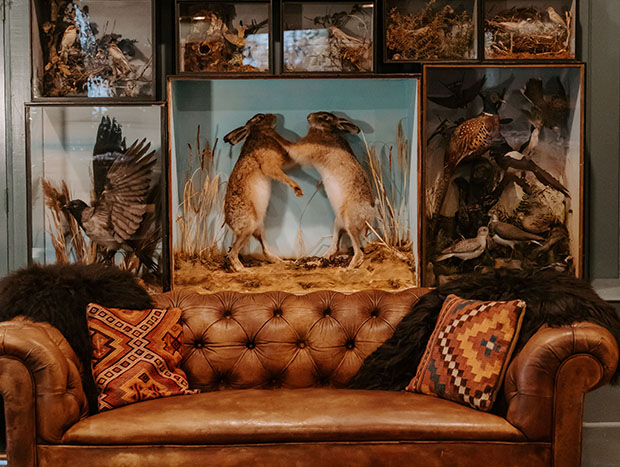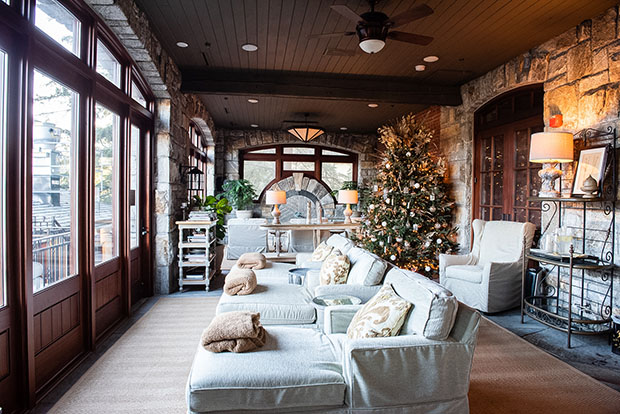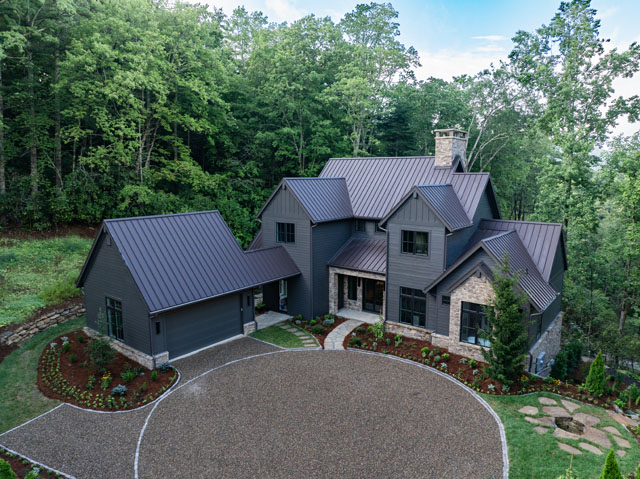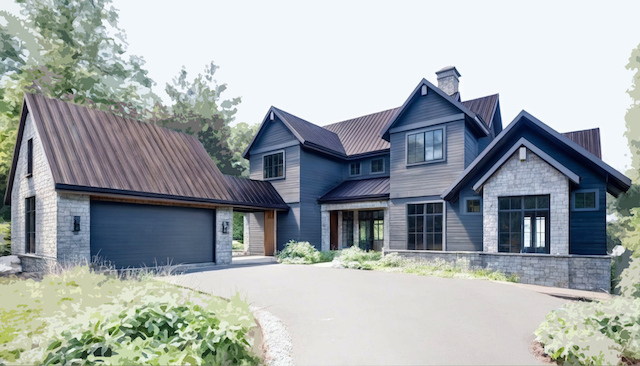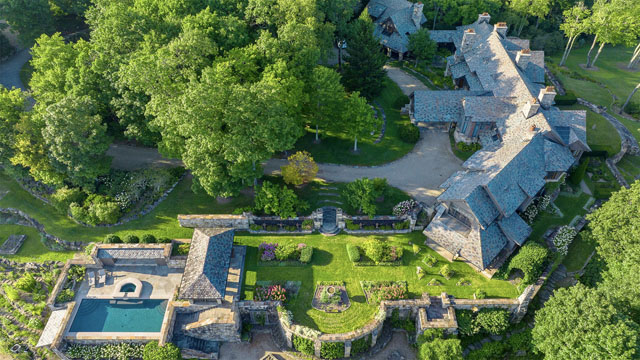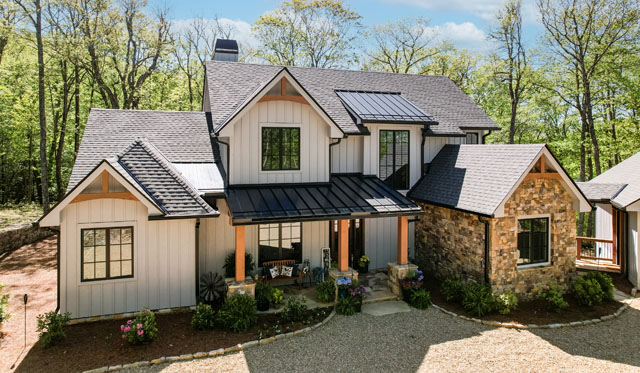Rising From the Ashes
03 Dec 2020
Saving a historic Highlands home
By Christine Hennessey Photos by Aaron Hogsed
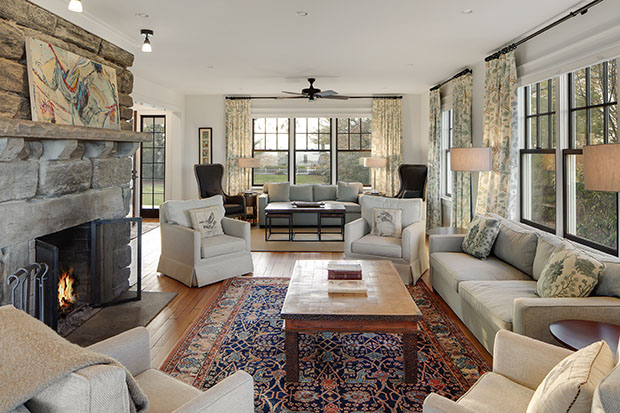
Ray McPhail was out at breakfast when he heard the firetrucks race by, sirens blaring. Not long after, he learned the trucks were headed to the historic home he co-owned with his business partner, Will Stolz. The fire at the 100-year-old Ravenel house, which served as both a beloved getaway and a guesthouse, started when some overnight guests used the fireplace. The fire they built ignited the creosote build-up in the chimney, then escaped the chimney through a chink in the mortar on the third floor. “It was like a blowtorch right at the roof level,” McPhail says. “Fortunately, the fire department was able to save the structure, but it was a close to total loss.”
McPhail and Stolz, developers by trade, acquired the estate the house was built on—320 acres, 200 of which they later sold to the Nature Conservancy at a reduced price—directly from the Ravenel heirs. The house had been built by the patriarch of the family in 1913 and was given to his daughter as a wedding present. It stayed in the family for over a century until it was sold to McPhail and Stolz.
“We weren’t going to keep the house at first,” Stolz says. “But as we started working on the property, we both fell in love with it. We put our business sense aside and decided to keep it, and we’ve owned it together ever since. Then we had this fire.”
The Ravenel house is a four-story home, including the basement. The attic level, which contains a sleeping loft, was the only part that actually burned, but the water damage sustained from putting out the flames was substantial. The plaster walls throughout the home were ruined, along with all the cabinetry and most of their furnishings. Restoring the Ravenel house would be a big project, but Stolz and McPhail knew it was their only option.
“After the fire, Ray and I talked about who we wanted to rebuild the house, and we both said John Lupoli,” Stolz says. “We had a great relationship with him, and we knew he was a straight shooter,” McPhail adds. “That was important to us.”
Forty years strong and counting
John Lupoli has been building homes in the Highlands area and beyond for over 40 years, and during that time, he’s seen shifts in the look and style that his clients want. “For the last 25 or 30 years, we did a lot of rustic, elegant, more traditional builds,” Lupoli says. “Now, tastes are starting to trend toward a more ‘modern mountain’ style. We still have people who come to this area and want a traditional mountain home—timbers, reclaimed wood flooring. But blending the traditional and the modern, taking that rustic style and putting it in a more modern setting—it’s a lot of fun.”
The firm also makes an effort to be environmentally responsible in both design and craftsmanship, in an effort to highlight the beautiful places in which they build. “Landscape is almost as important as the structure of the house,” Lupoli says. “One of the biggest challenges we find with our clients is interpreting their vision into a design that complements and honors both their lifestyle and the natural beauty of the area. This process is also the most rewarding part of what we do."
When a new client comes to Lupoli Construction, a project can go a few ways. “Some clients come to us after working with an architect on the design. They own the property and are ready to select a builder."
More and more, however, Lupoli is getting clients who want him involved from the very beginning, which he appreciates. “If they haven't purchased the land yet and they'd like us to evaluate the site to determine the type of home that would best suit the property, we are happy to do that,” he says.
Thanks to his long history of experience in the area, he can also recommend architects, structural engineers, energy raters, interior designers and any other professionals that might be needed to turn a client’s dream into reality.
The third option is working with Lupoli and his team on a design and build. While this route still leverages other professionals, it gives Lupoli full visibility into the project and the ability to oversee each step of the process from beginning to end. This helps them expediate the process and control costs, staying on schedule and within budget.
Then there are jobs like the Ravenel house, which was a unique project for Lupoli Construction. “Keep in mind this house was over 100 years old,” Lupoli says. During those years, it had been owned by different people, and the updates they made weren’t necessarily true to the time period or the history of the home. Lupoli saw this as an opportunity to restore the exterior of the house to its original glory while making interior updates that would create a more comfortable, livable and ultimately valuable home.
At first, McPhail and Stolz were apprehensive about making any big changes, preferring to put the house back exactly as it was before the fire. “At our first meeting with John, he said, ‘I’m sorry, boys, but that would be a huge mistake,’” Stolz remembers. At first, he was indignant, but Lupoli explained the house’s charms had led them to overlook details that were not up to current standards. “Things like the galley kitchen that was originally built for the hired help to cook in and was never meant to communicate with the rest of the house,” Stolz explains. “Or the tiny bathrooms that were borderline uncomfortable. No one lives like that today.”
“We had that opportunity to reset it,” Lupoli says. “We wanted to save as much as we could of the old and incorporate it back into the new.”
Restoration, with a few revisions
Stolz acknowledges the challenge of restoring a house owned by two separate families. “When you rebuild a house, there are ten thousand decisions to make,” he says. “That’s just part of the process. And we were smart enough to realize we would never get that house built if every time one of those decisions came up, somebody was going to call Ray and I and ask for input, and then we’d have to check with our wives, so we don’t get ourselves in trouble—it just wasn’t realistic. It was important to have someone who knew what he was doing and to trust him to do it. That’s exactly what John brought to the table. He restored the house and preserved the relationships we had with each other and with our wives.”
One of those key decisions was the location of the kitchen. “Before the fire, we had a wonderful old dining room right in the middle of the back of the house,” Stolz says. “It has a knock-your-socks-off view of the mountains. John walked in and said, ‘This is where the kitchen needs to be.’ Again, I was aghast, but he said put the kitchen here, open up the wall, and take advantage of the view. So, we did, and it instantly became the greatest feature of that house.”
“There’s not a more dramatic view in all of Highlands,” McPhail adds.
McPhail also had some apprehensions that Lupoli was able to appease. “One thing I resisted was adding a master suite. But one day, at some point, the house might be sold. And to sell a high-quality home today, you’ve got to have a master suite. So even though we didn’t need one, we put one in; it was smart because it added value to the home if we choose to sell it.”
While a number of updates were made, even more of the house that was perfectly preserved, a true homage to the home and a century’s worth of history.
“The house has beautiful hardwood floors that were at least an inch and a half thick,” Stolz says. Even though the floors were warped due to water damage after the fire, Lupoli was able to sand them down thanks to their thickness and keep them. He also salvaged the central staircase that was a key feature of the home, taking it apart, removing it from the premises during the restoration, and then bringing it back and reassembling it.
“The beautiful, weathered granite chimneys survived,” Stolz says. “The craftsman-style front door, which has been there since the very beginning, made it through the fire with a little TLC. All the original framing of the roof, all the original window openings, the front porch detailing, the column details—all of that was completely intact.”
But a house is more than building materials; it’s also made of memories. “Diane McPhail [Ray’s wife] was distraught about the fire,” Lupoli remembers. “Even though her parents’ bedroom set was destroyed, we were able to salvage these decorative scrolls from the headboard and footboard. We had them refinished, turned them into plaques, and presented them to her when the project was finished.”
The gift was emblematic of the whole project, a perfect symbol of how we can honor history for what it is was, while at the same time reshaping it for the future. As for the Ravenel house, here’s to another 100 years.
Resources:
Home Builder
Lupoli Construction
www.lupoliconstruction.com
828.526.4532
Photographer Aaron Hogsed www.aaronhphotographer.com
Interior Designer Darren Whatley

